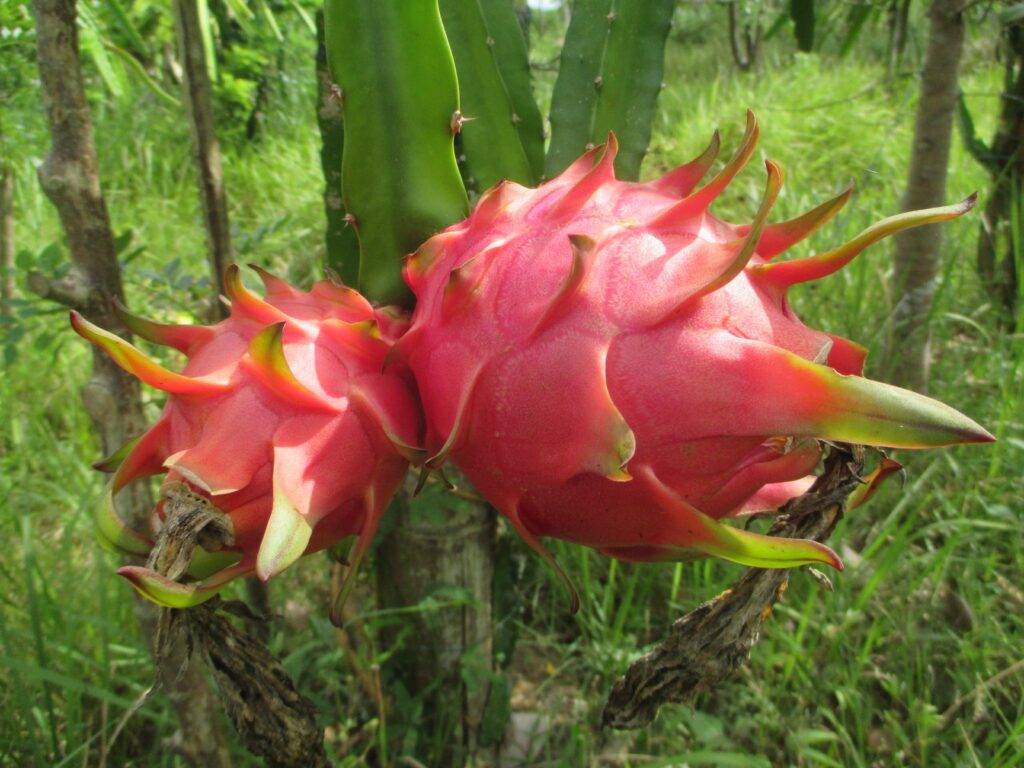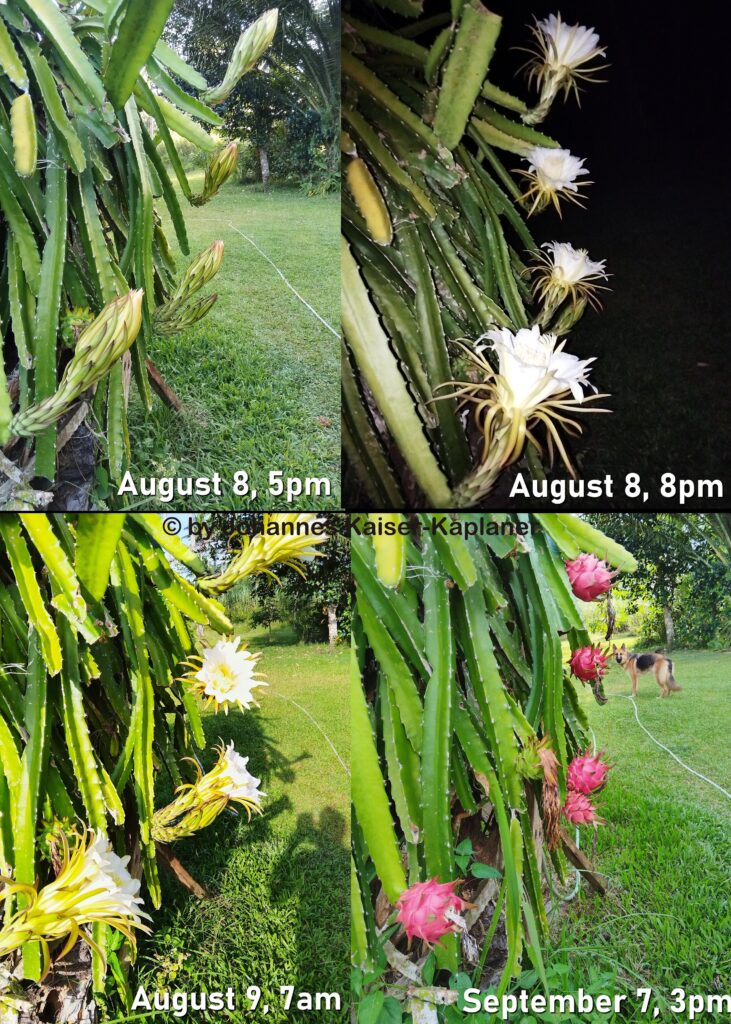How to Grow Dragon Fruit in your Backyard
How to Grow Dragon Fruit Plants: A Backyard Gardener’s Guide (Even in Small Spaces)
Your dragon fruit plant could outlive your car, your smartphone, and maybe even your mortgage. These subtropical cacti live for more than ten years and can keep producing fruit for 20 years (and even more) when you care for them properly.
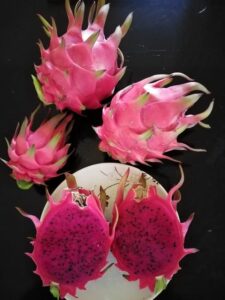 The plant itself might look like something from another planet – a climbing cactus that produces bright fuchsia-pink fruits dotted with tiny black seeds. Yet despite their exotic looks, dragon fruit plants aren’t the gardening challenge most people imagine. Here’s what surprised me most: Seeds need at least 5 years before they’ll give you fruit, but cuttings? They can start producing in just one to two years.
The plant itself might look like something from another planet – a climbing cactus that produces bright fuchsia-pink fruits dotted with tiny black seeds. Yet despite their exotic looks, dragon fruit plants aren’t the gardening challenge most people imagine. Here’s what surprised me most: Seeds need at least 5 years before they’ll give you fruit, but cuttings? They can start producing in just one to two years.
Small backyard? Tiny patio? No problem. While these climbing cacti prefer USDA zones 10-11 outdoors, they’re surprisingly adaptable. Grow them in containers and you can wheel them inside when winter arrives. No greenhouse required.
Picture this: You step outside one morning and pluck a ripe dragon fruit from your own plant. Whether you choose the classic bright pink varieties or go for something different with yellow ones, that first harvest feels pretty incredible.
You’ll learn exactly how to make this happen – from picking the right variety for your space to getting that first perfect fruit. Every step, every season, every trick that actually works for real gardeners growing these remarkable plants at home.
Choose the Right Dragon Fruit Variety
Your variety choice can make or break your dragon fruit growing experience. Get this part right, and you’re already halfway to success.
Self-fertile vs. self-sterile types
Dragon fruit plants fall into three pollination categories. Self-fertile varieties can make fruit using their own pollen, though they still need help getting that pollen to the stigma (the female part of the flower). White-fleshed varieties usually handle this better than red-fleshed ones.
Self-sterile varieties demand cross-pollination with another compatible plant to produce fruit. You’ll recognize these by their very long stigma that extends well beyond the anthers (pollen-producing parts). Most colored-flower varieties fall into this group. Do not plant self-sterile varieties unless you have a special reason to do so. So many Dragon Fruit Growers are dissapointed, because of their self-sterile varieties…
Then there are self-pollinating varieties – the easy button for dragon fruit growing. These plants have short stigmas buried right within the anthers, so pollination happens naturally as the flower moves. Of course self-pollinating varieties are also self-fertile, otherwise no pollination could happen…
Best beginner-friendly cultivars
Some varieties just work better for first-time growers:
‘Vietnam White‘ (Hylocereus undatus): High-yielding and self-fertile – perfect for beginners. This variety cranks out abundant pollen, making fruiting almost foolproof.
‘Sugar Dragon’: Both self-fertile and self-pollinating, plus it acts as a universal pollinator. Its pollen works with most other dragon fruit varieties, making it incredibly versatile.
‘American Beauty’ (Hylocereus guatemalensis): Fast-growing and self-fertile with rich pink flesh. Expect medium to large fruits weighing 0.5-1 pound.
‘Dark Star’: Stays manageable while producing delicious fruit. Same goes for ‘Sugar Dragon’ – both keep their size reasonable.
Got just one plant? Self-pollinating varieties eliminate the guesswork and boost your chances of getting fruit.
No Name varieties
Very often, the exact variety is unknown or it is a hybrid. So, the different species are often named after their fruit color, e.g., Red Dragon Fruit (with red or white flesh), White Dragon Fruit (with white flesh), or Yellow Dragon Fruit (yellow pitahaya), which corresponds to their typical skin color. There are also varieties with pink flesh, known as Pink Pitaya.
Red Dragon Fruit: Characterized by a red / pink skin and either white or red flesh. This is one of the most popular varieties – and – if it is self-pollinating, the best variety you can choose. You have to ask (and trust) the one, who give you (sell you) some cuttings.
White Dragon Fruit: Has a red skin and white flesh.
Yellow Dragon Fruit: This variety, also called Yellow Pitahaya, has a yellow skin and is often the variety with the most intense flavor.
Pink Dragon Fruit / Pink Pitaya: This has a pink skin and also pink, sometimes described as magenta, flesh.
Why these names work: These names help distinguish the different dragon fruits based on their distinctive characteristics. The color of the skin and flesh are the most important distinguishing features.
Why variety matters for small spaces
Small gardens don’t mean small dreams. Certain varieties were practically designed for tight spaces.
Edgar’s Baby works beautifully in small areas. This compact hybrid keeps its growth controlled compared to sprawling varieties, making patio growing much easier. Though it needs cross-pollination, it’s vigorous and produces stunning night-blooming flowers.
Little Winnie earned its nickname ‘The Dwarf Dragon’ for good reason. Everything about it stays small – roots, cuttings, flowers, and fruit. Perfect when space is at a premium.
What makes small-space varieties special:
- Controlled growth means less pruning headaches
- Container-friendly root systems
- Good fruit production despite compact size
- Reliable flowering once they get going
- Gorgeous looks (green stems, striking flowers, colorful fruit)
Choose varieties bred for containers and small spaces, and your garden size stops being a limitation.
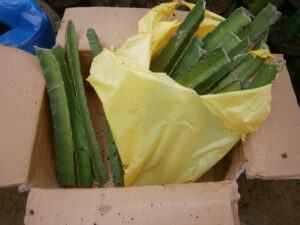 Start with Cuttings for Faster Results
Start with Cuttings for Faster Results
Skip the seeds. Seriously. If you want dragon fruit sometime this decade, cuttings are your best friend.
Why cuttings beat seeds every time
Here’s the math that matters: cuttings can produce fruit in just 1-2 years, while seeds make you wait at least 5 years.
That’s because cuttings are basically clones – they skip the whole “learning to be a plant” phase that seedlings go through.
But speed isn’t the only reason experienced growers stick with cuttings:
- Higher success rate than seeds, with fewer diseases and pests affecting established cuttings
- Genetic certainty – cuttings produce exact clones of the parent plant
- Less demanding care requirements compared to delicate seedlings
- Greater resilience to environmental stresses and growing conditions
Most serious growers won’t even bother with seeds for practical growing. The time difference is just too dramatic.
How to root your cutting (the simple way)
Get this right and your cutting will reward you for years. Here’s the process that works:
Start with the right size. Cut a healthy piece that’s at least 8-10 inches long from a mature plant. Longer cuttings have more energy stored up, which helps them get established faster. Don’t go shorter – they need that length to survive.
Let it heal first. This step trips up a lot of beginners. Set your cutting in a cool, dry spot away from direct sun until the cut end forms a tough callous. Usually takes 2-7 days. Skip this and your cutting will likely rot in the soil.
Mix the right soil. Grab a cactus or succulent mix and beef it up with perlite, vermiculite, sand, peat moss, or coco coir. Fill a 3-5 gallon container with this mixture – you’ll need the space later.
Plant it shallow. Only stick the bottom inch into the soil. Plant it deeper and you’re asking for rot problems. Keep that growing tip pointing up. .
Give it support right away. Dragon fruit is a climbing cactus that’ll fall over without help. A bamboo stake at least 18 inches long works perfectly.
Water carefully. Give your new cutting a drink, then wait. Only water again when the soil is completely dry. Many growers keep their cuttings in shade for some weeks while roots develop.
Some people root cuttings in water first, changing the water every few days until roots show up. Both ways work, though soil rooting tends to create stronger root systems.
Where to find good cuttings
The cheapest option? Ask around. Friends or neighbors who grow dragon fruit will usually share a cutting. These free cuttings work just as well as store-bought ones when you handle them right.
Garden centers are catching on to dragon fruit’s popularity and more are stocking plants and cuttings. These usually come with proper variety labels and are already rooted.
Online gives you the most choices. Specialized growers ship cuttings nationwide, and most reputable sellers offer pieces that are 12-15 inches long – these establish quickly once they arrive.
Whatever source you choose, make sure they can tell you exactly which variety you’re getting and how to care for it. This matters especially if you picked a specific type from the varieties we covered earlier.
Set Up Containers and Trellises for Small Spaces
Your container setup can make or break your dragon fruit success, especially when space is tight. Get the pot, support, and placement right, and even a tiny balcony can produce exotic fruits that impress your neighbors.
Choosing the right pot size and material
Start with a pot at least 10-12 inches deep and make sure it has good drainage holes. Your plant won’t stay small forever – plan ahead for a 25-30 gallon (100 liter) container with a depth of 20-24 inches once it matures. The sweet spot? A container 14-26 inches in diameter and 10-14 inches deep.
Forget lightweight plastic pots. They’ll tip over the moment your plant gets heavy with fruit. Ceramic or terra-cotta pots stay put and actually help your plant by letting excess moisture escape through the porous walls. Just check that your container has at least 2-3 drainage holes at the bottom.
Building a simple trellis or support
Dragon fruit plants climb, period. Without support, you’ll have a sprawling mess that produces little fruit. The easiest solution? A sturdy hardwood post, 4-6 feet long. Cedar and redwood last longest – skip pressure-treated lumber since the chemicals can harm your plant.
Here’s your basic setup:
- 4×4 wooden post anchored to a concrete pier block
- Bury the post 10-12 inches deep in your container
- Add a pinwheel design at the base for container stability
- Mesh panels give extra support as the plant grows
Don’t underestimate the weight. Mature dragon fruit plants plus their fruits create serious load(!), so build sturdy from the start.
Ideal placement for sunlight and airflow
Dragon fruit craves sun – 6-8 hours daily minimum. Find a spot where buildings and trees won’t cast shadows. Only in scorching climates should you provide light afternoon shade. Air circulation matters too. Good airflow prevents fungal problems and helps with pollination when those night-blooming flowers open. If frost hits your area, stick with containers you can roll indoors when winter comes.
Soil mix for drainage and nutrition
Standard potting mix will drown your dragon fruit. It holds too much water. Instead, mix your own: equal parts sandy soil, compost, and perlite. A 50-50 blend of cactus soil and compost works too. Toss some pebbles or bark at the bottom for extra drainage.
Dragon fruit isn’t a desert cactus – it actually needs rich, organic soil. Start with commercial cactus mix as your base, then boost drainage with sand, pumice, or extra perlite.
Get these fundamentals right, and your small-space dragon fruit setup will rival any full-sized garden installation.
Care and Maintenance for Healthy Growth
Your dragon fruit plant needs consistent care, but it’s not as demanding as you might think. Get a few key things right, and you’ll have a healthy, productive plant for years.
Watering schedule and moisture control
Dragon fruit plants want water, but they hate wet feet. The tricky part? Their thirst changes with the seasons. Spring calls for watering once or twice weekly, summer means stepping up to every 3-5 days, autumn slows down to every 10-14 days, and winter barely needs water – maybe once every 3-4 weeks.
Young plants act like teenagers – they need more of everything, including water. Fresh cuttings want a drink every 2-3 days until they settle in, but mature plants can wait 7-14 days between waterings.
Here’s the finger test: stick your finger 4-6 inches into the soil. Dry at that depth? Time to water. Morning watering works best – gives the plant all day to drink up before the heat hits.
Watch for these warning signs:
- Underwatering: Wrinkled stems, yellowing tips, sad little fruits
- Overwatering: Mushy stems, root rot, fruits that split open.
Fertilizing tips for each growth stage
Spring feeding sets the stage for good fruit later. Young plants do well with balanced fertilizer like 10-10-10 every two months. Mature plants only need feeding 3-4 times a year.
When flower buds start forming, switch to something phosphorus-heavy – try a 10-30-20 mix. This pushes flowers instead of just more leaves.
Prefer the organic route? Chicken manure, worm castings, mushroom compost, and seaweed extracts work beautifully. They feed slowly and actually improve your soil.
Pruning and training the vines
These plants grow like they’re trying to escape. One vine can shoot out 30 branches in a year. Left alone, they turn into green monsters that tip over.
Major pruning happens after harvest – usually October or November (depends on your location!). Cut back older branches and keep just 1-3 sub-branches per main stem. Big plants might need touch-ups 2-3 times yearly.
Three types of cuts to remember:
- Training pruning: Keep one main stem going up to your support
- Cleaning pruning: Remove anything dead, damaged, or diseased
- Production pruning: Thin out crowded areas, balance growth
Always cut back to the main stem at a 45-degree angle. Flat cuts collect water and invite problems.
Protecting from sunburn and cold
Dragon fruit plants like it warm – 65-80°F (20 – 27°C) feels just right. Anything below 40°F starts causing damage.
Winter protection starts with dry soil. Wet roots freeze faster. Pile mulch around the base to prevent “cold collaring”. Frost cloth or straw wrapping helps too.
Hot sun can burn new plants. Give them some weeks to get used to full sun gradually. Whitewash the main stems to prevent sunscald. Plants with bluish-gray stems handle bright sun better naturally.
The difference between a thriving plant and one that just survives? Protection when it counts.
Pollination, Flowering, and Harvesting
Your dragon fruit is finally ready to show off. The mature plant starts its most exciting phase – those spectacular night-blooming flowers that turn into the fruits you’ve been waiting for.
How to hand-pollinate dragonfruit flowers
Dragon fruit flowers open at night and close by morning. You’ll need to work fast, but the process is simple:
- Get a small makeup brush ready when buds look about to bloom
- Wait until after sunset when the flower opens
- Brush gently against the anthers – those frond-like structures loaded with pollen
- Take that same brush and stroke it across the stigma, the central part sticking up
Self-sterile varieties need pollen from a different compatible plant. No second, different plant? No fruit.
Signs of successful pollination
Watch what happens over the next 4-7 days. Success looks like this:
- The flower part yellows and drops off
- The base stays green and firm on the branch
- You’ll see a clear line where green meets yellow
Failed pollination? The whole thing turns yellow and falls off. Back to the drawing board.
When and how to harvest ripe fruit
Most varieties need 32-45 days after flowering to ripen. Thorny varieties can take up to six months. Look for:
- Full color change
- Shriveled fins
- Fruit that feels loose when you touch it
Post-harvest care and storage tips
Here’s the thing about dragon fruit: it won’t ripen after you pick it. Time your harvest right or you’ll regret it.
Once picked:
- Uncut fruit keeps in the fridge for 3 days
- Cut fruit in plastic bags lasts 3-4 days maximum
- Chill before eating for the best taste (I personally prefer these directly after harvest).
That first bite of your homegrown dragon fruit? Worth every bit of effort you put into getting here.
Conclusion
Your dragon fruit journey doesn’t have to be perfect from day one. These climbing cacti forgive mistakes better than most plants, and they’ll reward your patience with years of exotic fruit production right from your own space.
The variety you choose matters more than having a huge garden. Those self-fertile types like ‘Vietnam White’ or space-saving options like ‘Edgar’s Baby’ can turn even the smallest patio into a productive growing area. Get your container and support system right, and you’re already ahead of most beginners.
Cuttings save you years of waiting compared to seeds – that’s the single biggest shortcut in dragon fruit growing. Your first harvest might arrive sooner than you expect, especially if you stay consistent with seasonal care and don’t skip the hand pollination step.
Here’s the truth: watching those massive night-blooming flowers turn into bright pink or yellow fruits feels pretty amazing. Even better when you realize this exotic-looking plant will keep producing for decades with basic care.
Start with one cutting, learn what works in your specific conditions, then expand from there. Soon you’ll have neighbors asking how you managed to grow something so unusual in such a small space. That first bite of homegrown dragon fruit makes every step worth it.
FAQs
Q1. How long does it take for dragon fruit plants to produce fruit?
Dragon fruit plants grown from cuttings can produce fruit in just (1 – ) 2 years, while those grown from seeds typically take at least 5 years to reach fruiting maturity.
Q2. What’s the best way to grow dragon fruit in small spaces?
For small spaces, grow dragon fruit in large containers with good drainage. Use a sturdy trellis or support system, and choose compact varieties like ‘Edgar’s Baby’ or ‘Little Winnie’ that are well-suited for container growing.
Q3. How often should I water my dragon fruit plant?
Watering frequency varies by season. In spring, water once or twice weekly. During summer, increase to every 3-5 days. In autumn, water every 10-14 days, and in winter, reduce to once every 3-4 weeks. Always check soil moisture before watering.
Q4. Do I need to hand-pollinate dragon fruit flowers?
Hand-pollination is often necessary, especially for self-sterile varieties or in areas lacking natural pollinators. When flowers open at night, gently transfer pollen from the anthers to the stigma using a small brush for best results.
Q5. What are the signs that a dragon fruit is ready to harvest?
Harvest dragon fruit when it has fully changed color, the fins appear shriveled. Most varieties ripen 32-45 days after flowering. Remember, dragon fruit doesn’t continue ripening after picking, so timing is crucial.
Links
How do I grow dragon fruit from cutting?
Fertilizer for Your Dragon Fruit
Dragon Fruit tree Training and Pruning
How to Pick Dragon Fruit
Youtube:
Signs of Successful Dragon Fruit Pollination
Build a Dragon Fruit Trellis
Rooting/Propagating Dragonfruit Cuttings 2 Ways – Soil & Water
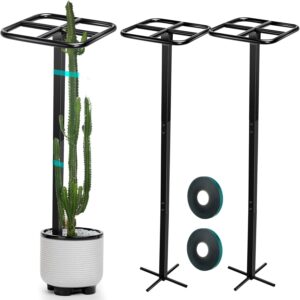 Amazon: Dragon Fruit Trellis
Amazon: Dragon Fruit Trellis
- Package Content: includes 2 Metal Garden Trellises (12 x 60 inch) and 2 Stretch Ties, perfect for supporting dragon fruit and climbing plants.
- Material: made of quality coated metal suitable for indoor and outdoor use, designed to handle heavy climbing plants.
- Size: 12 x 60 inch black trellises with 147 feet of 1/2 inch stretch ties provide ample space for plant growth without taking up too much garden area.
- Assembly: easy to install with included items and instructions.
- Usage: versatile support system suitable for dragon fruit, climbing plants, and ornamental trees.
- Buy it on Amazon
